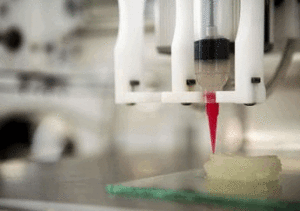 By: Diana Holan, MS
By: Diana Holan, MS
Inkjet printers use multiple ink cartridges to layer out an image on paper. In the 1980s, 3D printers were developed from the same concept, except the cartridges are filled with various materials that merge together in layers onto a flat surface, guided by a computer generated pattern that actually builds a 3D item in the printer. Also known as “additive manufacturing”, engineers have long used this technique for creating a single prototype model in their own offices that was then mass produced in factories. It eliminates the need for glue or staples and allows new design variations. As the technology developed, medical and cybernetic researchers also began to use these printers, except now, they experiment with various combinations of “bio-ink”, nutrients and a growing medium in order to build 3D tissues and organs.
In 2012, Alan Faulkner-Jones, et al, at Heriot-Watt University in Scotland, developed a 3D printer that distributes the very delicate human stem cell bio-ink as tiny spheres, which fuse together and grow into a specified 3D body part. In May 2013, Michael McAlpine, et al, at Princeton University reported they had 3D printed an ear by combining cartilage cell bio-ink with inductive ink that was then laid down in the shape of a human ear. After giving it 10 weeks to grow, follow up tests showed that it “hears” radio frequencies far beyond human capabilities. They are not yet able to add skin, but this is the first time electronics and tissue have been “grown” together. They believe the immediate potential of this bionic ear is to more easily connect humans to their personal devices!
Interestingly, researchers at the University of Warwick developed a new conductive plastic they named “carbomorph” that is 3D printed in combination with electronic tracks and sensors that could be customized ergonomically for an ear, hand or other body part and that would also respond to individualized tactile patterns. And Jennifer Lewis, et al, at Harvard University have developed electrochemically active ink to 3D print rechargeable, lithium ion “microbatteries” that are smaller than a single grain of sand, that were then combined and printed into a conductive electrode stack that is narrower than a human hair.
So what amazing developments are within reach? Imagine personalized organs or various medical patches (skin, heart, kidney) – custom built using a patient’s own stem cells as bio-ink, electronic sensors and microbatteries. The patches would reduce the ongoing problems associated with tissue rejection and they could be monitored by computer scan for maintenance and function. For audiology, 3D printers could make very small hearing aids already imbedded with circuitry and microbatteries. Until these ideas become reality, talk to us about how hearing aids can help. Technology is constantly improving, which helps us provide our patients with more opportunity to connect to the world around them.
 Diana Holan, MS, has been practicing audiology for over 20 years in Tucson and is committed to improving communication between patients and their families through the use of state-of-the-art hearing aid technology and various assistive techniques. She received a BS in Speech and Hearing and an MS in Audiology from the University of Arizona.
Diana Holan, MS, has been practicing audiology for over 20 years in Tucson and is committed to improving communication between patients and their families through the use of state-of-the-art hearing aid technology and various assistive techniques. She received a BS in Speech and Hearing and an MS in Audiology from the University of Arizona.







It is really a true fact that three-dimensional technology has brought a revolution to these latest technology based digital platform. It is also emerging day by day and has also applied in various platforms as well.